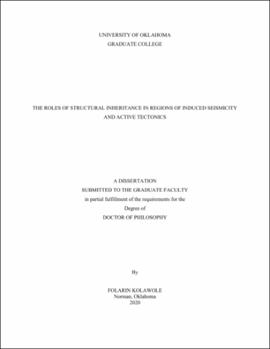| dc.description.abstract | The structural fabric of crystalline crustal rocks, commonly defined by fractures, metamorphic foliation, tabular intrusions, bedding planes, cleavage etc. represent mechanical anisotropy and structural weakness which are exploited by subsequent tectonic and anthropogenic stressing (induced seismicity) events. In this dissertation, two overarching questions are explored: 1.) What are the roles of inherited crustal deformation in the seismogenic release of elastic strain in areas of sporadic and widespread induced seismicity? 2.) What are the controls of structural inheritance on strain accommodation within contractional and multiphase extensional tectonic settings? The first question is explored in the intraplate induced seismicity setting of the Central – Eastern United States (CEUS), and the second question in the Anadarko Basin, Oklahoma, U.S. and the Shire Rift, Southern Malawi, Eastern African Rift System. In this dissertation, field observations, 3-D seismic reflection data, earthquake data, potential field (aeromagnetic & gravity) datasets, and experimental rock mechanics testing are integrated to address the research questions in the different study areas where appropriate. Among several interesting findings, the results of this dissertation work can be summarized as follows: 1.) In areas of sporadic basement-hosted induced seismicity, the geometry, structure, and mechanical stability of the basement faults make them critically susceptible to seismic reactivation. Furthermore, the presence of a regional-scale structural fabric in an area of anthropogenic stress perturbation facilitates the production of widespread regional-scale induced seismicity. 2.) In juvenile multiphase continental rift settings, the structures that are inheritance from the pre-rift basement and the subsequent phases of extension may influence the patterns of lengthening, widening, bifurcation, and even the episodic termination of propagating rifts. Furthermore, the results show that magmatic structures and basement fabrics represent sustained controls on multiphase rift development. Overall, the various studies presented in this dissertation provide compelling evidences suggesting that pre-existing structures and tectonic conditions promote and sustain subsequent crustal deformation and the associated seismicity in regions of anthropogenic stress perturbations (induced seismicity) and active tectonics. | en_US |

